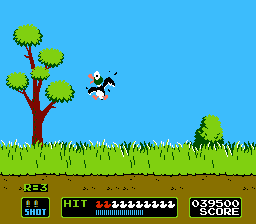
Nintendo’s 1984 critically acclaimed first person shooter game, Duck Hunt, asks its players to shoot randomly appearing ducks on screen with its exclusive gun controller, the NES Zapper light gun, in a variety of game modes. In later versions of the game, one player uses the light gun controller to shoot the ducks while the second player uses the classic controller to try to maneuver the ducks out of their sights. At its core, it is a very simple game with a clear objective and rule set.

What I found my interesting about this game is tin part he requirements needed in materials to actually play this game as it is intended and designed, and not on an emulator. Duck Hunt not only needs a special gun controller, but also requires a specific type of television for the gun’s signal to be received and actionable for gameplay: a CRT television and not an HDTV or LCD television. More than most video games, which utilize buttons or keys for gameplay, this game requires more aim, precision, and a different type of motor control.
My experience with this game comes from playing it at my grandmother’s house, where my uncle with special needs lived. Duck Hunt, his favorite game since he was a child, allowed him to have more ability to experience game play, regardless of skill level and dexterity with aiming, with its untraditional discarding of buttons for controls, which his fingers could not navigate nearly as smoothly.
While there is a different conversation to have about how the physicality of this game could be more limiting to some than traditional gaming controllers, there it something to be said about how different mechanics for gameplay could be used to allow a wider variety of audiences and players to have access and appeal for the game. As technology has significantly advanced since the mid ’80s when this game appeared, it is important for game designers to have accessibility and appeal to less traditional gaming audiences in mind!
Perhaps when thinking of how to make games both more enjoyable and accessible for future audiences, designers should look back and think about how the evolution of gameplay has evolved, and what areas of deviation from the norm included or excluded different communities of gamers.


